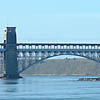
| Britannia Bridge
Britannia Bridge (Pont Britannia) is a bridge across the Menai Strait between the island of Anglesey and the mainland of Wales, originally a tubular bridge of wrought iron rectangular box-section spans, and now a two-tier steel box girder and arch bridge.
The opening of the Menai Bridge in 1826, a mile (1.6 km) to the east of where Britannia Bridge was later built, provided the first road link between Anglesey and the mainland. However, the increasing popularity of rail travel necessitated a second bridge to provide a direct rail link between London and the port of Holyhead. The task of building such a bridge fell to Robert Stephenson, son of the locomotive pioneer George Stephenson. Constrained by the fact that the strait must remain accessible to shipping, and that it must be sufficiently stiff to support the heavy loading associated with trains, he constructed a bridge with two main spans of 460-ft (140-m) long rectangular iron tubes, each weighing 1,500 tons, supported by masonry piers, the centre one of which was built on the Britannia Rock. Two additional spans of 230-ft (70-m) length completed the bridge making a 1511-ft (461-m) long continuous girder. Up until then the longest wrought iron span had been 31 ft 6 in (9.6 m). The bridge was decorated by four large lions sculpted by John Thomas, two at either end.
Stephenson retained the services of two distinguished engineers as consultants. William Fairbairn was an old friend of his father. Eaton Hodgkinson was a leading theorist on strength of materials. Hodgkinson believed that it would be impractical to make the tubes stiff enough, and advised auxiliary suspension from chains. However, Fairbairn believed chains unnecessary declaring:
Provided the parts are well proportioned and the plates properly rivetted, you may strip off the chains and have it as a useful Monument of the enterprise and energy of the age in which it was constructed.
The consensus of received engineering opinion was with Hodgkinson, but Stephenson, rather nervously, backed Fairbairn's analysis. However, a 75-ft (25-m) span model was constructed and tested at Fairbairn's Millwall shipyard, and used as a basis for the final design.
Begun in 1846, the bridge was opened on 5 March 1850. For its time, it was a bridge of "magnitude and singular novelty", far surpassing in length contemporary cast beam or plate girder iron bridges. One aspect of its method of construction was also novel; the box sections were assembled on-shore, then floated out into position before being lifted into place. In spite of the heavier loadings placed on it in its later life, the bridge was "one of the most easily maintained and successful railway bridges" in the UK, and "as the first really large wrought iron bridge of the girder type it has unique significance in civil engineering history". Stephenson went on, in short order, to design the High Level Bridge in Newcastle Upon Tyne, which can be seen as a second and more elegant version of the Britannia Bridge; and the design of the bridge and the construction techniques employed also influenced Isambard Kingdom Brunel in the design and construction of the Royal Albert Bridge across the River Tamar at Saltash.
During the evening of 23 May 1970 the bridge was greatly damaged when boys playing in the bridge dropped a burning torch, starting a fire. As a consequence the bridge was completely rebuilt, with the spans supported by archways. The deck has two levels: the lower still carries the rail line, and the upper supports a single-carriageway section of the A55 road. The Anglesey Coastal Path passes below the bridge.
Stephenson's only other tubular iron bridge, the Conwy railway bridge between Llandudno Junction and Conwy, remains in use, and can be seen at close quarters from another of Telford's elegant suspension bridges crossing the River Conwy. |







